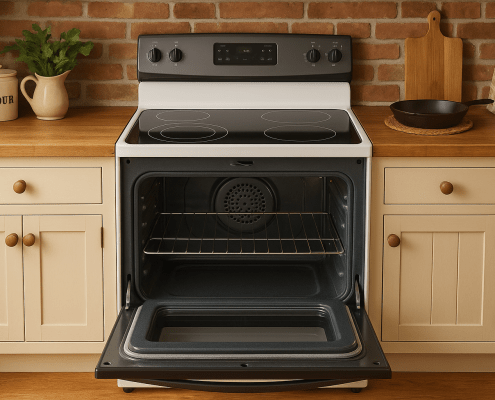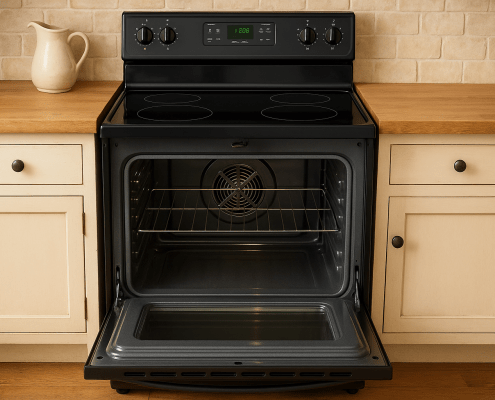Is Your Samsung Oven Baking Element Dead? Find Out Now!
Steven E / Friday September 26, 2025
Looking for the right part? Enter your appliance model number below to find the exact match and get your appliance running like new again!
If your Samsung range isn’t heating properly, bakes unevenly, or won’t heat at all, the culprit is often the bake element. This component is responsible for producing the heat that cooks your food during the bake cycle, and when it fails, your oven simply can’t do its job.
The good news? Testing and replacing a bake element is a straightforward DIY project. With just a couple of screwdrivers, a multimeter, and our video, you can diagnose the issue and install a new part yourself.
Why the Bake Element Is Important
The bake element is the hidden heating coil located at the bottom of your oven. Unlike the broil element at the top, which provides intense heat from above, the bake element delivers steady, even heat from below. Together, these elements ensure your food cooks properly.
When the bake element fails, you might notice:
- The oven won’t heat at all.
- Food cooks unevenly (burned on top, raw on the bottom).
- Preheating takes much longer than usual.
- The oven temperature never reaches the setting.
If you’re experiencing one or more of these issues, it’s time to test the bake element.
Tools You’ll Need
For this repair, you’ll only need a few basic tools:
- Multimeter (for checking resistance)
- Phillips head screwdriver
- Flathead screwdriver
Safety First
Before working on your oven, unplug it or switch off the breaker. You’ll be working with electrical components, so cutting power is critical for your safety.
Step 1: Testing the Bake Element
The first step is confirming whether the bake element has failed.
- Pull the range out: Carefully slide the range forward so you can access the back.
- Remove the back panel: Use your Phillips screwdriver to take out the screws holding the panel in place. Set the panel aside.
- Locate the bake element: It’s at the very bottom of the oven assembly. In many Samsung ranges, it’s hidden from view when you look inside the oven.
- Disconnect one wire: Remove one of the wires from the element’s terminals to prevent false readings.
- Set your multimeter: Switch to resistance mode (symbol looks like an upside-down horseshoe, Ω).
- Test the terminals: Place one probe on each terminal of the bake element.
Results:
- A healthy bake element should read around 17–20 ohms.
- If the reading is much higher, much lower, or shows “O” (open line), the element is faulty and needs replacing.
Step 2: Removing the Old Bake Element
If your test confirms the bake element is faulty, here’s how to remove it:
- Detach the terminal block: This block connects the element to the wiring. Remove it and push it gently aside.
- Expose the mounting screws: Move aside the insulation near the terminals.
- Remove screws: Unscrew the Phillips screws holding the bake element in place, there should be one on each side.
- Disconnect wires: Pull the wires off the element terminals.
- Remove the element: Carefully slide the bake element out of its housing.
At this point, the old bake element is free, and you’re ready to install the replacement.
Step 3: Installing the New Bake Element
- Insert the new bake element: Slide it into position at the bottom of the oven.
- Reconnect the wires: Push the wire connectors onto the new terminals securely.
- Secure with screws: Use your Phillips screwdriver to reinstall the mounting screws.
- Reinstall the terminal block: Reattach the block you moved earlier.
- Replace the back panel: Line it up and reinstall all the screws you removed.
Step 4: Testing Your Repair
Now it’s time to confirm the repair worked.
- Plug the range back in or flip the breaker on.
- Set the oven to Bake at 350°F.
- Watch for the oven preheating normally, even heat distribution, and no error messages or delays.
If everything checks out, your repair was successful.
Tips for DIY Success
- Take photos before disconnecting wires: This makes reassembly foolproof.
- Keep screws in small containers: Avoid losing important hardware.
- Check the broil element too: If you’ve had ongoing heating issues, the broil element may also need inspection.
- Replace with the correct part: Always order parts using your range’s model number to ensure compatibility.
Why Bake Elements Fail
Bake elements endure extreme heat cycles every time you use your oven. Over time, this stress can lead to failure. Common causes include:
- Normal wear and tear: After years of use, the coil simply burns out.
- Electrical surges: A sudden spike in voltage can damage the element.
- Physical damage: Heavy cookware or spills can harm the element.
- Moisture buildup: Excess steam or spills can corrode terminals.
Replacing the bake element restores reliable performance and prevents further strain on the control board.
Preventing Future Problems
While bake elements eventually wear out, you can extend their life with a few habits:
- Avoid using excessively heavy cookware directly on racks above the element.
- Clean spills quickly to prevent residue buildup.
- Use the self-cleaning cycle sparingly, as extreme heat can shorten element life.
- Don’t slam oven doors, shock vibrations can damage internal parts.
Where To Find Us
If you need any replacement parts for your appliances, you can enter your model number at AppliancePartsPros.com to locate and order them quickly. Most orders arrive in just two business days, and we have tons of great information in our repair help section and YouTube videos to help you troubleshoot.
Stay connected with the latest DIY tips, tutorial videos, and repair guides by following us on Facebook, Instagram, and Twitter. We love hearing about your repair stories and successes. If you need more help or want personalized guidance, feel free to contact or call us at 877-477-7278. We’re ready to help you take on your next project with confidence!
Since 1999, AppliancePartsPros.com has helped millions of people repair their broken appliances by providing high-quality original parts at well below retail prices, free support and troubleshooting, and award-winning customer service from an expert, friendly, US-based customer support team!
With nearly a decade of experience in providing top-notch customer service regarding appliance parts and repair, Steven enjoys sharing practical advice, troubleshooting tips, and interesting information to help readers stay informed.






Leave a Reply
Want to join the discussion?Feel free to contribute!